I’ve worn a WHOOP strap since January 2019, and recently purchased the Fitbit Sense — Fitbit’s flagship smartwatch — to write this side-by-side comparison.
In this article, I’ll take a deep dive into the activity and sleep tracking features of both wearables and tell you which one is the better overall fitness tracker.
While I encourage you to read the entire article, you can get a glimpse of how WHOOP and Fitbit compare based on the table below.
| Fitbit Sense | WHOOP 4.0 | |
|---|---|---|
| Heart rate tracking | ✓ | ✓ |
| Workout tracking | ✓ | ✓ |
| Automatic workout detection | ✓ | ✓ |
| Calorie tracking | ✓ | ✓ |
| Support for chest straps (HR) | ✘ | ✘ |
| HR broadcasting | ✘ | ✓ |
| Guided workouts | With subscription | ✘ |
| Strain tracking | ✘ | ✓ |
| Sleep tracking | ✓ | ✓ |
| Sleep stage analysis | With subscription | ✓ |
| Sleep quality score | ✓ | ✓ |
| Recovery score | With subscription | ✓ |
| Battery life | 2 to 6 days | 5 days |
| Pricing | $299.95 + $9.99 (optional premium subscription) | $18 to $30 per month |
Note that the table above and the remainder of this article focus predominantly on the fitness and sleep tracking aspects of these devices; I won’t be discussing the aspects of Fitbit Sense that are related to its function as a smartwatch, such as its screen and the ability to send and receive messages.
WHOOP Strap 4.0 vs. Fitbit Sense

Fitbit (a company that was acquired by Google in January 2021) offers a variety of fitness trackers and wearables, including the Fitbit Inspire 2 and the Fitbit Versa. For this side-by-side comparison, I decided to purchase the Fitbit Sense because it’s Fitbit’s flagship model and features similar hardware (i.e., sensors) as the WHOOP strap.
Given the technical similarities between the two devices, my expectation was that the Fitbit Sense and WHOOP would be on about the same level as far as accuracy is concerned. Continue reading to find out if that assumption turned out to be true based on my testing.
As I mentioned above, the Fitbit Sense is more than a fitness tracker. It’s a smartwatch too, similar to the Apple Watch that I’ve been wearing for more than four years. However, for this review, I’ll only focus on the following health-related categories:
- Activity coaching and tracking.
- Sleep coaching and tracking.
- Recommendations for improving fitness and sleep quality.
I should also point out that to get many of the detailed sleep, health and activity tracking features offered by the Fitbit Sense, you have to sign up for Fitbit’s premium subscription. I’ve made sure to point out the premium features in every section of this review, so you get an idea of what the Fitbit Sense can and cannot do without a monthly subscription.
So let’s dive in, starting with a comparison of the devices’ hardware, followed by the main reason why people buy a fitness wearable: activity tracking.
Whoop vs Fitbit: Hardware and Sensors
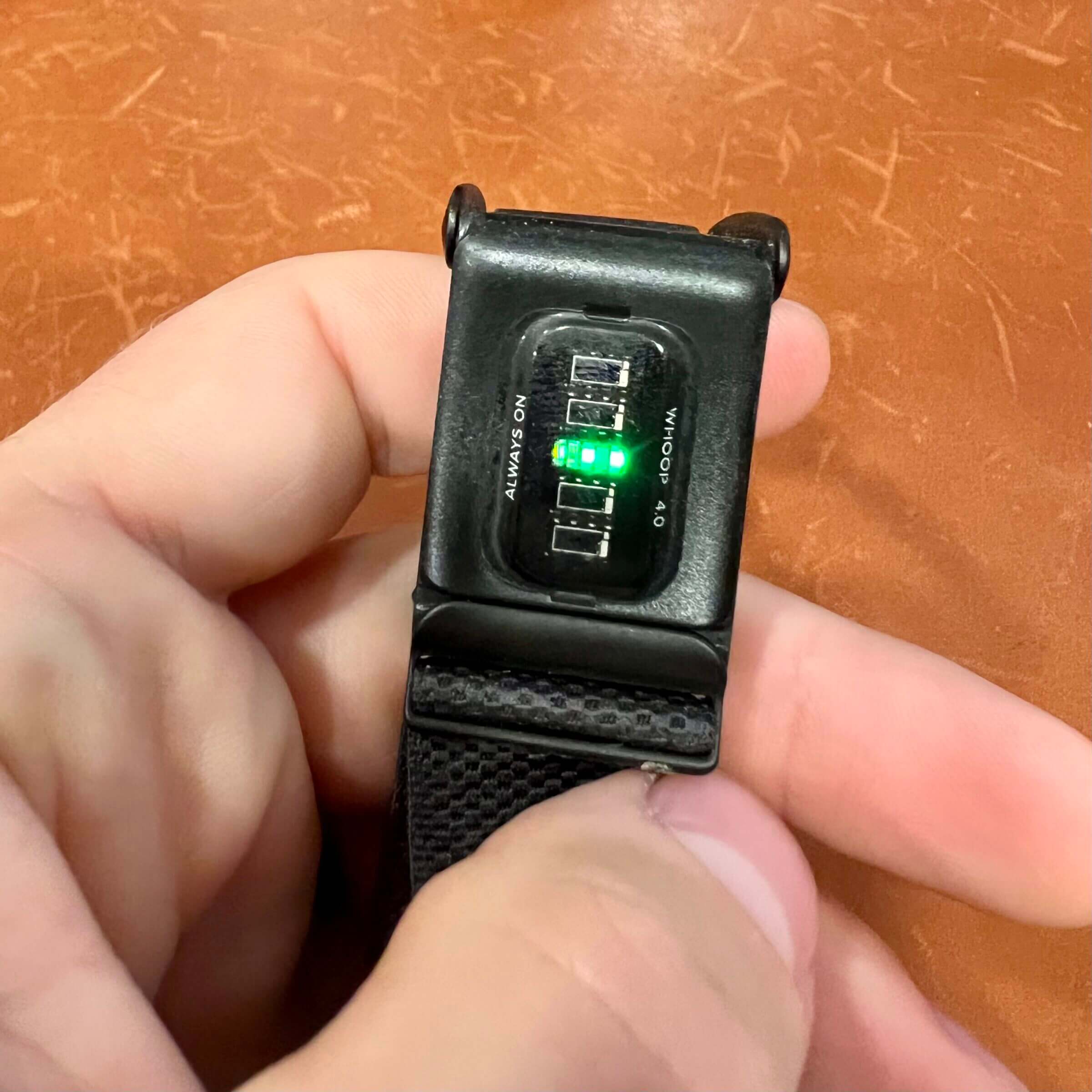

Aside from WHOOP, the Fitbit Sense is the only fitness wearable I’ve ever used that’s equipped with every type of sensor you need for accurate activity and sleep tracking.
Based on the table below, you might even get the impression that the Fitbit Sense is superior in some of the categories.
| Fitbit Sense | WHOOP 4.0 | |
|---|---|---|
| 3D accelerometer and gyroscope | ✓ | ✓ |
| Optical heart rate sensor | Mix of green, red and infrared LEDs | Mix of green, red and infrared LEDs |
| Pulse oximeter | ✓ | ✓ |
| NTC (negative thermal coefficient) body temperature sensor | ✓ | ✓ |
| Electrodermal activity (skin conductance) sensor | ✓ | ✓ |
| Sampling rate | One-second intervals during exercise tracking and five-second intervals all other times | 100 times per second |
| Interchangeable straps | ✓ | ✓ |
| Electrocardiogram (ECG) | ✓ | ✘ |
What impressed me most about the Fitbit Sense is that it features a body temperature and electrodermal activity sensor. These two sensors are crucial for accurate sleep tracking, and all of the sleep trackers that I reviewed (except for WHOOP) lack them.
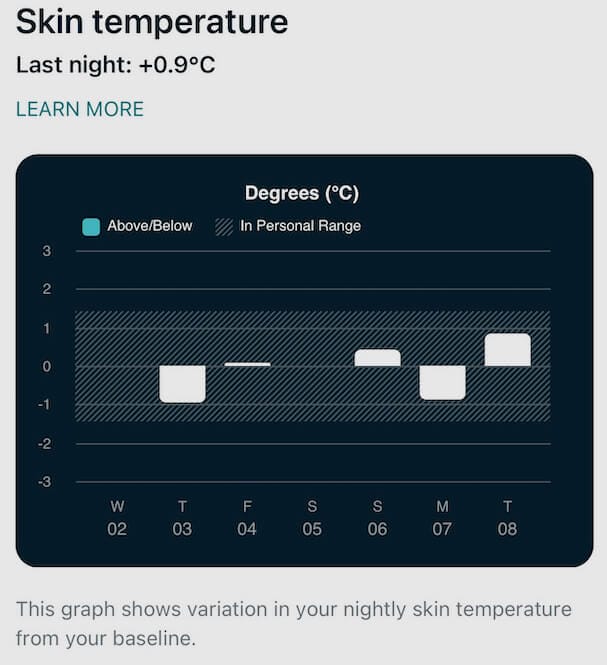
Another feature that I like about the Fitbit Sense is the combination of green, red and infrared LEDs, which enables the tracking of blood oxygen saturation (SpO2). Additionally, the Sense can record an electrocardiogram (ECG) using one of its built-in apps.
You can also find both of these features in the Apple Watch, which I compared to the WHOOP strap in this article.
As far as the sample rate is concerned, the Fitbit Sense captures heart rate information at a dramatically lower rate than WHOOP. The consequence of that is that the Sense might miss sudden spikes or drops in heart rate, thus lowering the device’s accuracy during both activity and sleep tracking.
By comparison, WHOOP captures heart rate data at a rate of 100 times per second.

Another area that can dramatically impact the accuracy of the optical heart rate monitor is the strap, because it directly influences how well the sensor remains in contact with the skin at all times.
The silicone strap that came with my Fitbit Sense is very similar to the Sport Band my first Apple Watch came with, and it’s absolutely awful for several reasons.
First, it’s a pain to put on. But more importantly, it’s difficult to make it tight enough without tightening it to the point of discomfort. That’s one of the reasons why I replaced the Sport Band with the Sport Loop for my Apple Watch.
Unfortunately, Fitbit doesn’t appear to offer alternative straps for its wearable device that are similar to Apple’s Sport Loop or Solo Loop. That means you have to purchase a third-party strap like this one I found on Amazon.
However, my experience has been that many third-party wristbands are cheaply-made and break after a while. You can see some examples of that in my review of the best fitness straps for the Apple Watch.

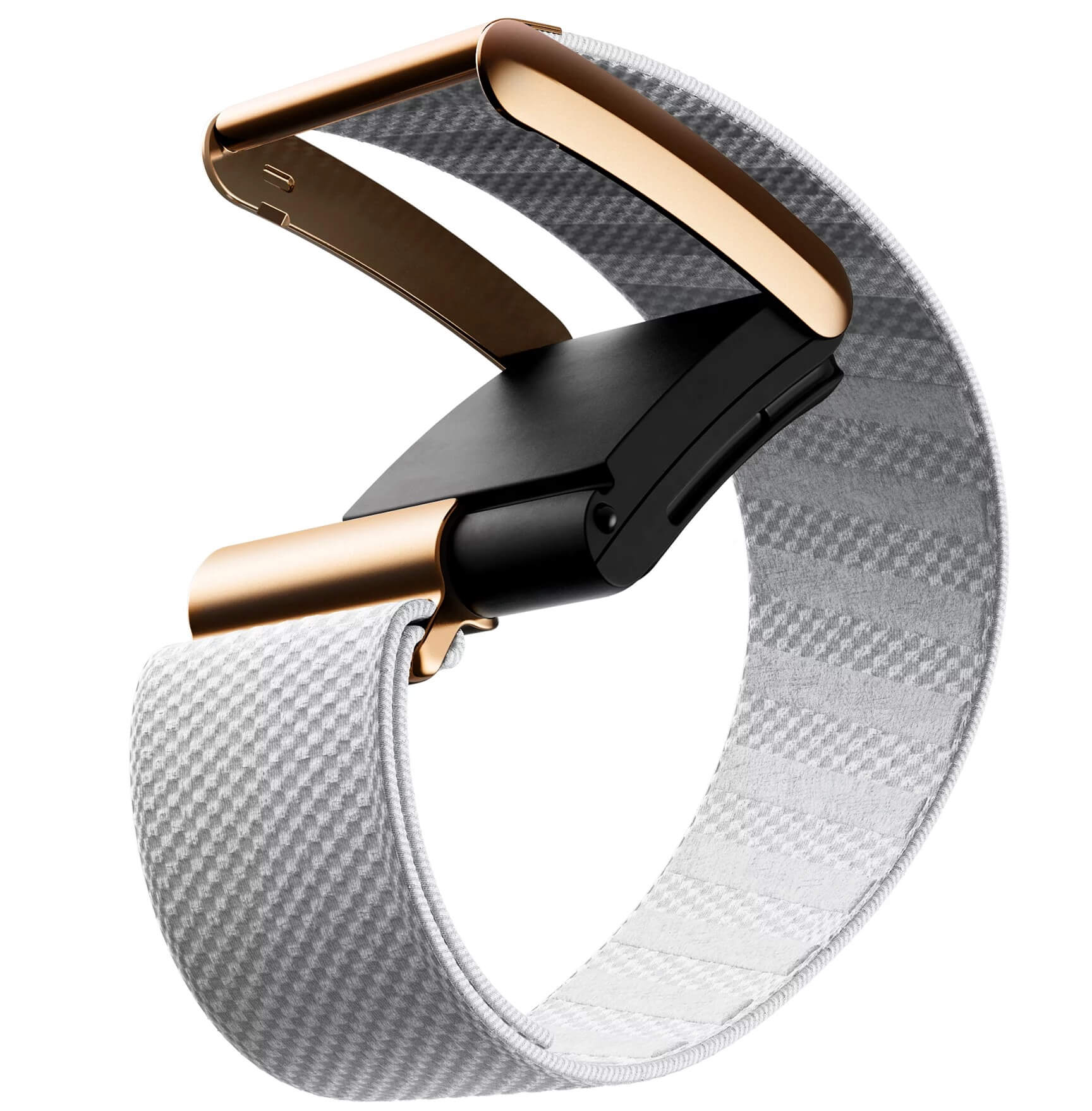
WHOOP, on the other hand, ships with a SuperKnit strap that’s incredibly comfortable, is easy to adjust, and that keeps the sensor in good contact with the skin at all times.
For reference, WHOOP 3.0 shipped with the ProKnit band, which was also superior to Fitbit’s silicone band. However, the advantage of silicone is that it’s easy to keep clean, because you can just rinse it in soapy water. That’s an advantage if you work in a medical setting, or somewhere where germs might be an issue.
Activity and Workout Tracking
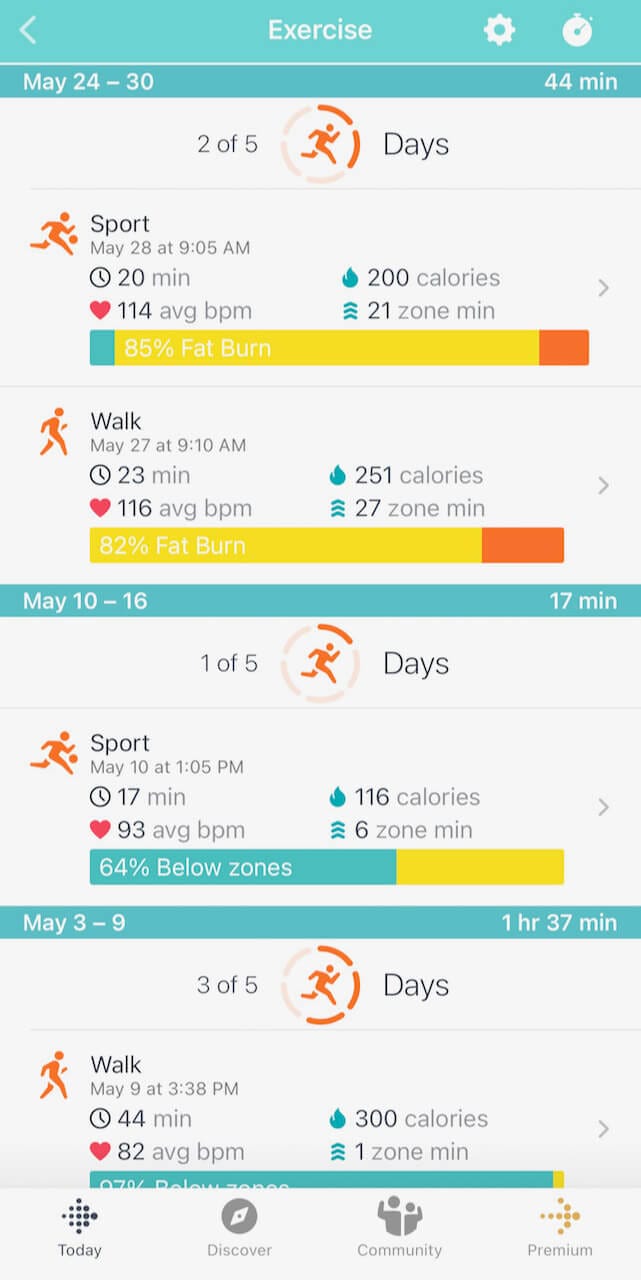


When fitness wearables started hitting the market a few years ago, they relied on either a pedometer or a heart rate monitor to count steps and/or calories.
These days, advanced activity trackers like the Fitbit Sense and WHOOP use a combination of sensors and algorithms to monitor a range of biometric signals. They can even differentiate between different types of workouts based on your movement and heart rate patterns — sometimes automatically.
For example, both the Sense and WHOOP use a combination of an optical heart rate sensor and a 3D accelerometer and gyroscope to figure out if you’re jogging, walking or swimming.
| Fitbit Sense | WHOOP 4.0 | |
|---|---|---|
| Automatic workout detection | Walk, run, outdoor bike, elliptical, sports, aerobic workout, swimming | Detects all previously-logged workout types |
| Number of workout types | 20 | 87 |
| Workout detection threshold | 15 minutes | 15 minutes and a minimum strain score of eight |
| Scoring model | HR zones (fat burn, cardio) | Cardiovascular strain |
| Active calorie tracking | ✓ | ✓ |
| Step counting | ✓ | ✘ |
| Distance tracking | ✓ | ✘ |
| HR broadcasting | ✘ | ✓ |
| External HR monitor (chest strap) support | ✘ | ✘ |
| Recommendations | Weekly exercise goals | Strain coach, sleep coach |
| Post-workout analysis | Raw metrics and HR zones | Metrics and recommendations |
| Community | Badges and activity sharing | Teams |
The table above gives you an overview of the activity tracking features of both devices, which we’ll go into in more detail in the following paragraphs.
While there are a few similarities between the two wearables, they follow a slightly different approach to activity tracking.
Fitbit takes a more traditional approach to fitness tracking in that it counts metrics including steps taken, calories burned, floors climbed and/or distance walked (measured using the built-in GPS and your stride length), and then compares your progress to predefined daily or weekly fitness goals.
In other words, the idea is to encourage you to keep moving throughout the day so that you reach these goals.
Additionally, the Fitbit Sense offers a scoring model based on what the company calls “Zone Mins.” These “Zone Minutes” are calculated based on how much time you spend in elevated heart rate zones.

Specifically, Fitbit categorizes any physical activity that gets your heart pumping into three zones:
- Fat Burn
- Cardio
- Peak
For each minute you spend in the Fat Burn zone, you get credited with one Zone Minute. For each minute you spend in the Cardio or Peak zone, you get two Zone Minutes.
All of these Zone Minutes count towards your weekly fitness goal, which is set to 150 by default. You can change that goal based on your personal activity level, but 150 minutes is what the American Heart Association recommends.
Note: The AHA also claims that “eating foods that contain saturated fats raises the level of cholesterol in your blood,” which has long been debunked. So take the 150-minute recommendation with a grain of salt.
If you do the math, that’s 22 minutes per day — a goal you should be able to hit even if you don’t go to the gym. A brisk 20-minute walk, combined with walking up and down the stairs a few times, should do the trick.
WHOOP takes a somewhat different approach to activity tracking. It doesn’t keep tabs on traditional metrics such as steps taken, distance walked (it doesn’t have a GPS) or floors climbed. Instead, WHOOP focuses on scoring (cardiovascular) strain, which is calculated by tracking how much time you spend in an elevated heart rate zone.

The specific heart rate you have to reach before you get strain credits depends on your personalized heart rate reserve, which is the difference between your resting and peak heart rate.
In other words, if you have a peak heart rate of 200 (as tracked by WHOOP), and a resting heart rate of 50 (while sleeping), then your calculated heart rate reserve is 150. Any time your heart rate is elevated to 30% of your heart rate reserve (105 based on this example), you start accumulating strain.
What’s interesting is that WHOOP measures your heart rate 24/7. As a result, you can accumulate strain even when you’re not exercising. That’s because common activities — such as getting grocery bags from the car, stress or excitement — can elevate your heart rate and cause strain on your cardiovascular system.
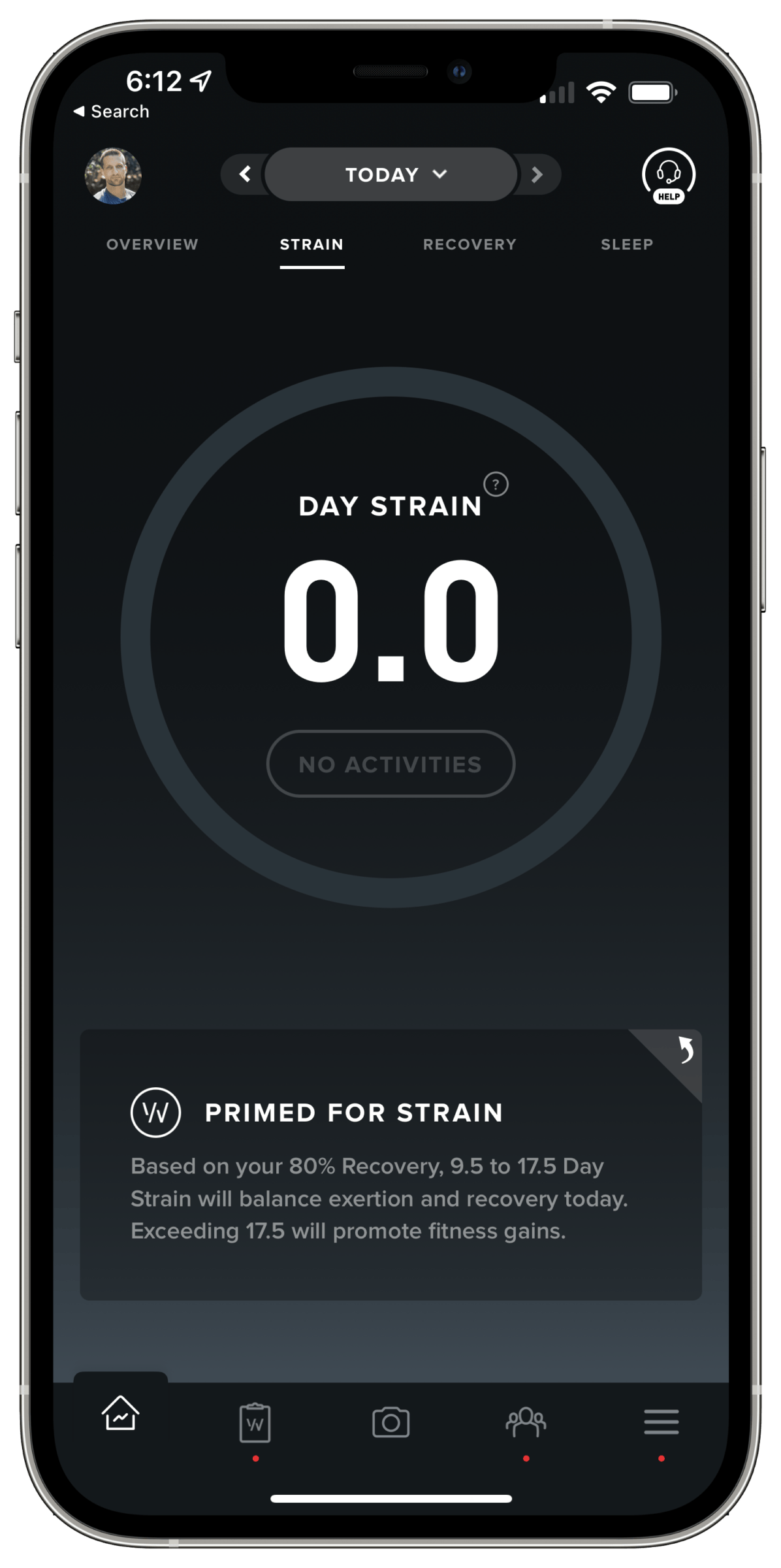
Case in point: sometimes, the WHOOP app already shows strain early in the morning, even though I’ve only been in front of my computer writing for my blog. That’s because, evidently, my heart rate went up to 30% of my personal heart rate reserve (86 bpm) since I woke up — maybe while I took the dog out, or because I got super excited about all the new orders I received for my beef liver supplements overnight.
What’s The Point of the Strain Score?
WHOOP’s Sleep Coach uses the strain you’ve accumulated during the day to calculate your sleep needs. The harder your heart and cardiovascular system work during the day, the more rest you need.
Related: Learn more about what happens during sleep and why sleep performance is essential for recovery in my sleep guide.
Besides indicating how your strain impacts your sleep needs, WHOOP also gives you feedback on whether the strain you’ve accumulated on a given day supports your recovery and leads to fitness gains. Additionally, every morning, WHOOP offers you a target strain recommendation based on your personalized recovery score (which we’ll talk about shortly).
These are just a few examples of how WHOOP provides context and actionable information around the health data and metrics it tracks, instead of just showing you raw numbers and then leaving it up to you to interpret them.
That said, I do see value in both approaches.
If you don’t have an established exercise routine and you struggle with moving enough throughout the day, then Fitbit’s approach is reasonable because it keeps you accountable for taking enough steps and accumulating enough “Zone Mins,” an approach that’s somewhat similar to WHOOP’s strain score in that it keeps tabs on how much time you spend in an elevated heart rate zone.
Personally, I prefer WHOOP’s approach because I have a set exercise routine (I do CrossFit 4-6 times per week), so the metrics tracked by Fitbit are relatively meaningless to me. I’m not going to change my workout routine because I’m not consistently taking 10,000 steps per day.
To learn more about how WHOOP tracks strain, check out my dedicated WHOOP review and the accompanying WHOOP video review.
Sleep Coaching and Tracking
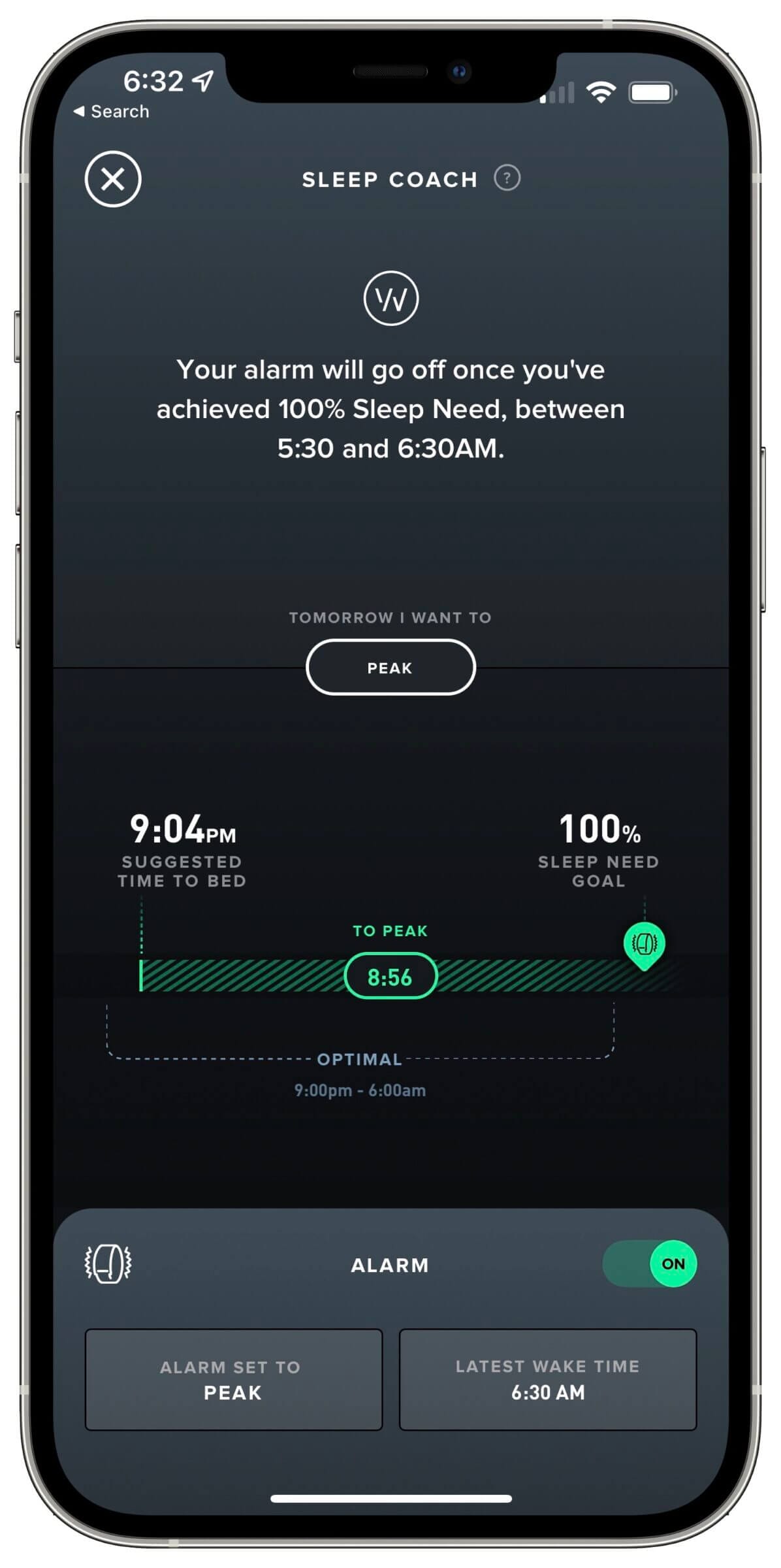
I’m incredibly protective of my sleep and I follow a relatively strict routine that ensures my circadian rhythm doesn’t get disrupted.
As a rule, I go to bed between 8:30 and 9 p.m., and wake up between 5 and 6 a.m. on most days.
To better understand the quality of my sleep and the lifestyle factors that influence it, I’m a huge fan of gadgets that can accurately track sleep metrics and, in particular, the stages of sleep (also called the sleep cycles) — such as light, deep (slow-wave) and REM sleep.
Considering that I’ve been incredibly satisfied with WHOOP’s sleep tracking capabilities, I was excited to find out how the Fitbit Sense would stand up in comparison — especially since the Sense is the only gadget (besides the WHOOP band and Muse S — a brain-sensing headband) I’ve tried with the sensors necessary for accurately monitoring sleep performance, including skin temperature and skin conductance (also known as electrodermal activity or EDA).
The table below offers a top level side-by-side comparison of the sleep tracking features of each wearable device.
| Fitbit Sense | WHOOP 4.0 | |
|---|---|---|
| Sleep goals | Manual | Calculated |
| Total time asleep | ✓ | ✓ |
| Sleep efficiency | ✓ | ✓ |
| Detailed sleep stage tracking | With subscription | ✓ |
| Respiratory rate | With subscription | ✓ |
| Skin temperature | With subscription | ✓ |
| Sleep improvement recommendations | Bedtime reminder (based on fixed schedule) | Recommends a bedtime and total sleep need |
| Analytics and correlations | ✘ | ✓ |
As you can see, both the Fitbit Sense and the WHOOP strap appear to be playing on the same level as far as features are concerned — as long as you’ve signed up for the Fitbit premium subscription.
Without a subscription, you only get an overall “Sleep Score” and basic sleep tracking capabilities, similar to that of the Apple Watch or lower-priced Fitbit devices.
I was curious to find out how those hardware similarities would translate into sleep tracking accuracy (and sleep stage tracking in particular).
The comparison tables below show sleep metrics from three consecutive days as measured by my smart mattress from Eight Sleep, Fitbit Sense and WHOOP.
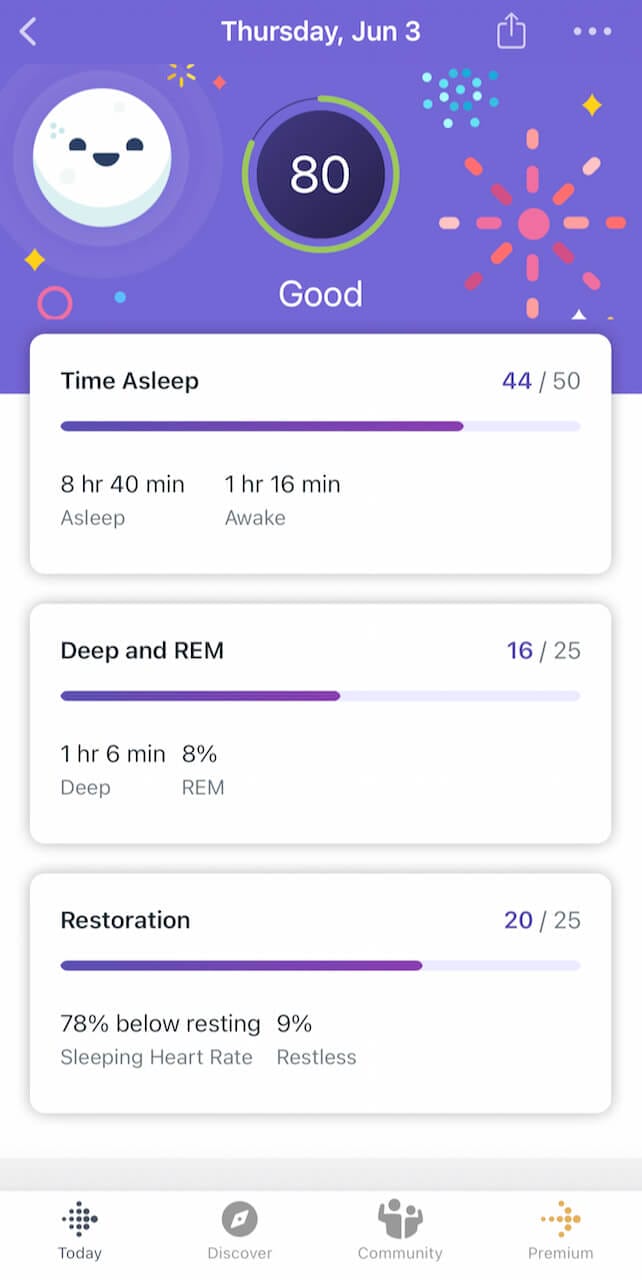
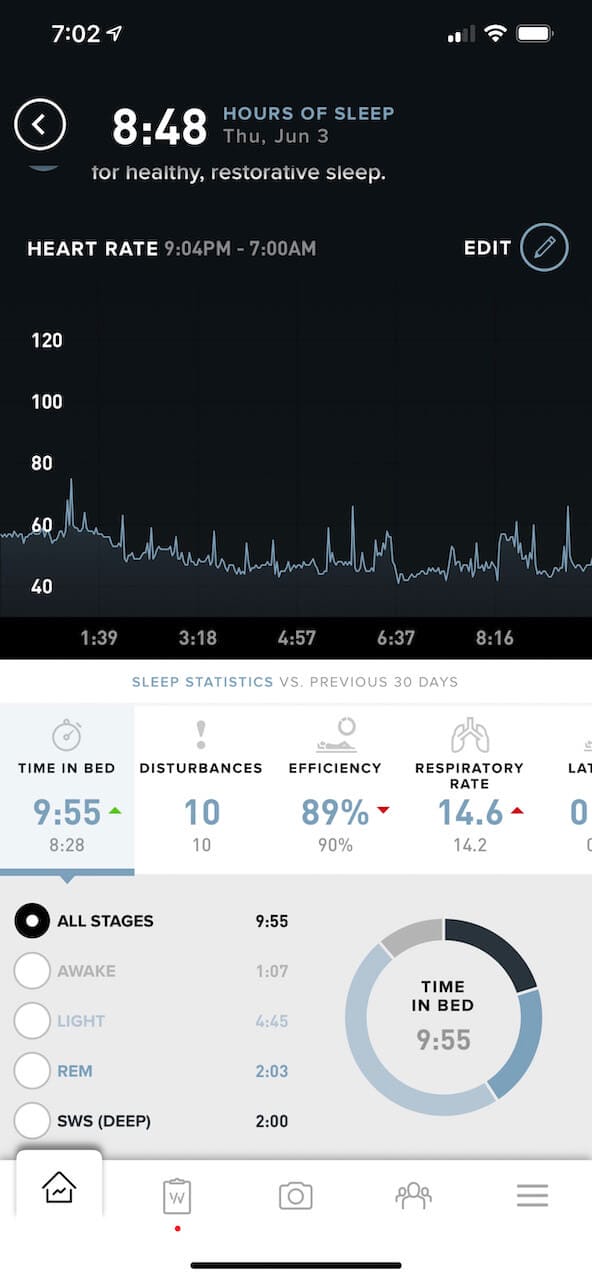
| Day 1 | Eight Sleep | Fitbit Sense | WHOOP |
| Time I fell asleep | 9:08 p.m. | 8:36 p.m. | 9:02 p.m. |
| Time I woke up | 5:37 a.m. | 5:35 a.m. | 5:20 a.m. |
| Light sleep | 5:21 | 6:11 | 4:46 |
| Deep sleep | 1:27 | 1:04 | 1:16 |
| REM sleep | 1:42 | 0:16 | 1:23 |
| Day 2 | Eight Sleep | Fitbit Sense | WHOOP |
| Time I fell asleep | 9:17 p.m. | 9:05 p.m. | 9:13 p.m. |
| Time I woke up | 5:48 a.m. | 5:47 a.m. | 5:50 a.m. |
| Light sleep | 5:07 | 5:22 | 3:20 |
| Deep sleep | 1:31 | 1:31 | 1:47 |
| REM sleep | 1:51 | 0:41 | 2:39 |
| Day 3 | Eight Sleep | Fitbit Sense | WHOOP |
| Time I fell asleep | 9:32 p.m. | 9:30 p.m. | 9:29 p.m. |
| Time I woke up | 5:42 a.m. | 5:54 a.m. | 5:43 a.m. |
| Light sleep | 4:59 | 5:17 | 4:13 |
| Deep sleep | 1:33 | 0:44 | 1:28 |
| REM sleep | 1:43 | 1:01 | 1:26 |
Overall, I can say that the Sense and WHOOP often agree on when I fell asleep and when I woke up.
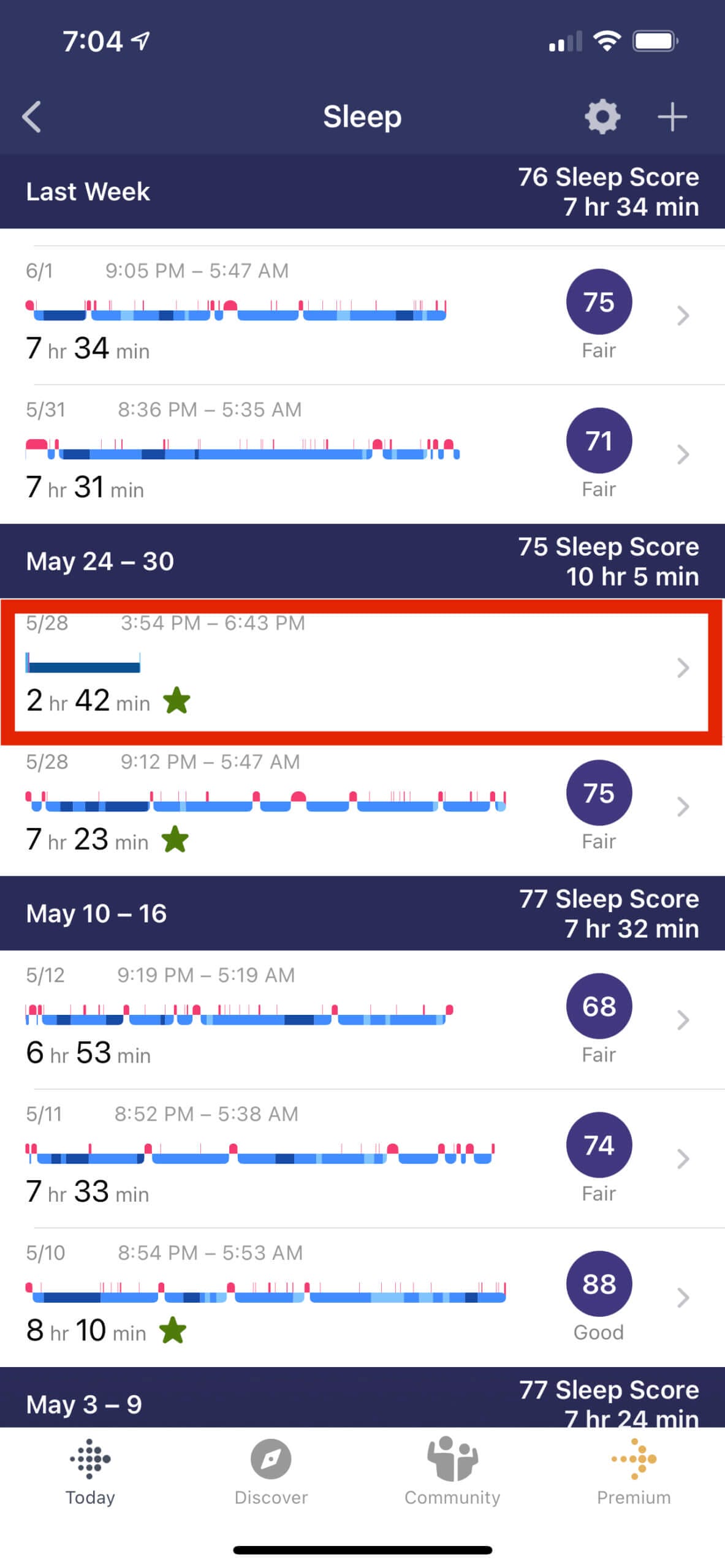
With one exception: on one of the days during my test, the Fitbit Sense thought I was sleeping between 3:54 and 6:43 p.m. I don’t know what I did during that time, or if I was even wearing the Sense (it might have been charging) — but I was definitely not napping. In comparison, WHOOP has never misidentified periods of no movement (i.e., watching TV) as sleep.
Both devices are within the margin of error when it comes to detecting deep sleep, which is arguably the easiest stage of sleep to correctly detect.
That’s because during deep sleep, the body’s temperature and heart rate are usually at their lowest levels, and there should be little to no (wrist) movement involved. In other words, the body is like a vegetable during this phase of sleep.
On the other end of the spectrum is REM sleep, which is an active phase of sleep that involves movement, including rapid eye movement, which is where the name REM comes from.
This phase of sleep is very difficult to differentiate from light sleep because in both phases you typically show increased heart rate and movement patterns.
It’s also the stage of sleep where the most vivid dreams occur. Based on my experience of waking up in the middle of a dream and matching that experience with my WHOOP data, I’m relatively confident of WHOOP’s ability to detect REM sleep.
But don’t take just my word for it: an independent validation study conducted at the University of Arizona confirms that WHOOP is accurate at detecting the various stages of sleep when compared to polysomnography (PSG), the gold standard in sleep tracking.
So when I see dramatic discrepancies between WHOOP and other sleep trackers I’m testing, I tend to trust WHOOP’s data.
Based on the sleep data my Fitbit Sense has captured so far, I believe that it’s struggling with accurately differentiating between light and REM sleep. As a result, my conclusion is that the Sense might be more accurate than most of the other wrist-worn sleep trackers I’ve tested in the past, but is no match for the WHOOP Strap.
I suspect the reason for this might be that WHOOP uses a better algorithm to make sense of the raw data. As I mentioned above, both light and REM sleep can show very similar heart rate patterns because they’re “active” stages of sleep, and perhaps Fitbit’s algorithm has trouble differentiating them.
It could also be that Fitbit isn’t using all of its available hardware for sleep tracking, especially the electrodermal activity and skin temperature sensors. Another reason could be that WHOOP uses more or better data to train its algorithm in detecting the various stages of sleep.
The unfortunate consequence of the Sense’s inability to accurately detect REM sleep is that your overall sleep score will be inaccurate because REM and deep sleep combined make up 25% of it. The other factors include total time asleep (50%) and a combination of resting heart rate and restlessness (25%).
The other problem with the Sense is that it doesn’t correlate lifestyle or exercise choices with changes in sleep pattern like WHOOP does.
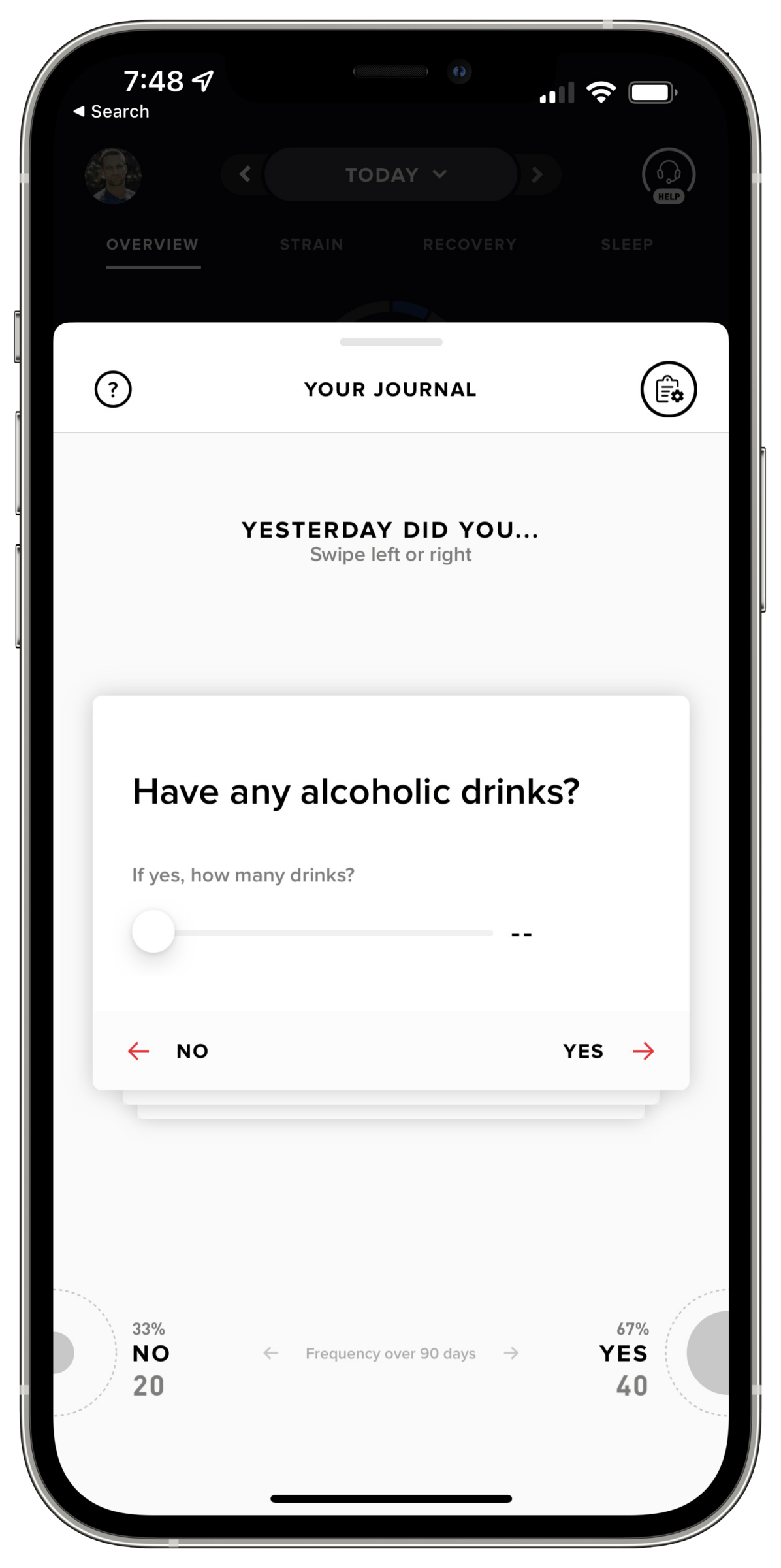
The latter has what the company calls the WHOOP Journal, a platform that encourages users to answer a customizable list of questions every morning. WHOOP then correlates the answers to those questions with changes in sleep pattern, sleep quality and recovery.
For example, every morning after waking up I input data into the WHOOP app, such as:
- Alcohol consumption.
- Supplements I took (e.g., melatonin).
- Diet (paleo, keto, meat-based, etc.)
- Late meals.
The list above shows just four out of the eight data points I choose to provide to WHOOP every morning.
Based on my answers, WHOOP provides weekly and monthly reports that correlate that information with changes in the duration of deep and REM sleep, among other things.
Fitbit doesn’t do that — you have to draw these correlations yourself.
My advice is that if you’re interested in the Fitbit Sense as your primary sleep tracker, despite its shortcomings, don’t get too hung up on the amount of REM sleep the device thinks you got, or your overall sleep score.
If you care about getting the most accurate sleep data possible from a wrist-worn device — and want the ability to correlate lifestyle choices with sleep patterns — I’d recommend signing up for WHOOP.
Recovery Score
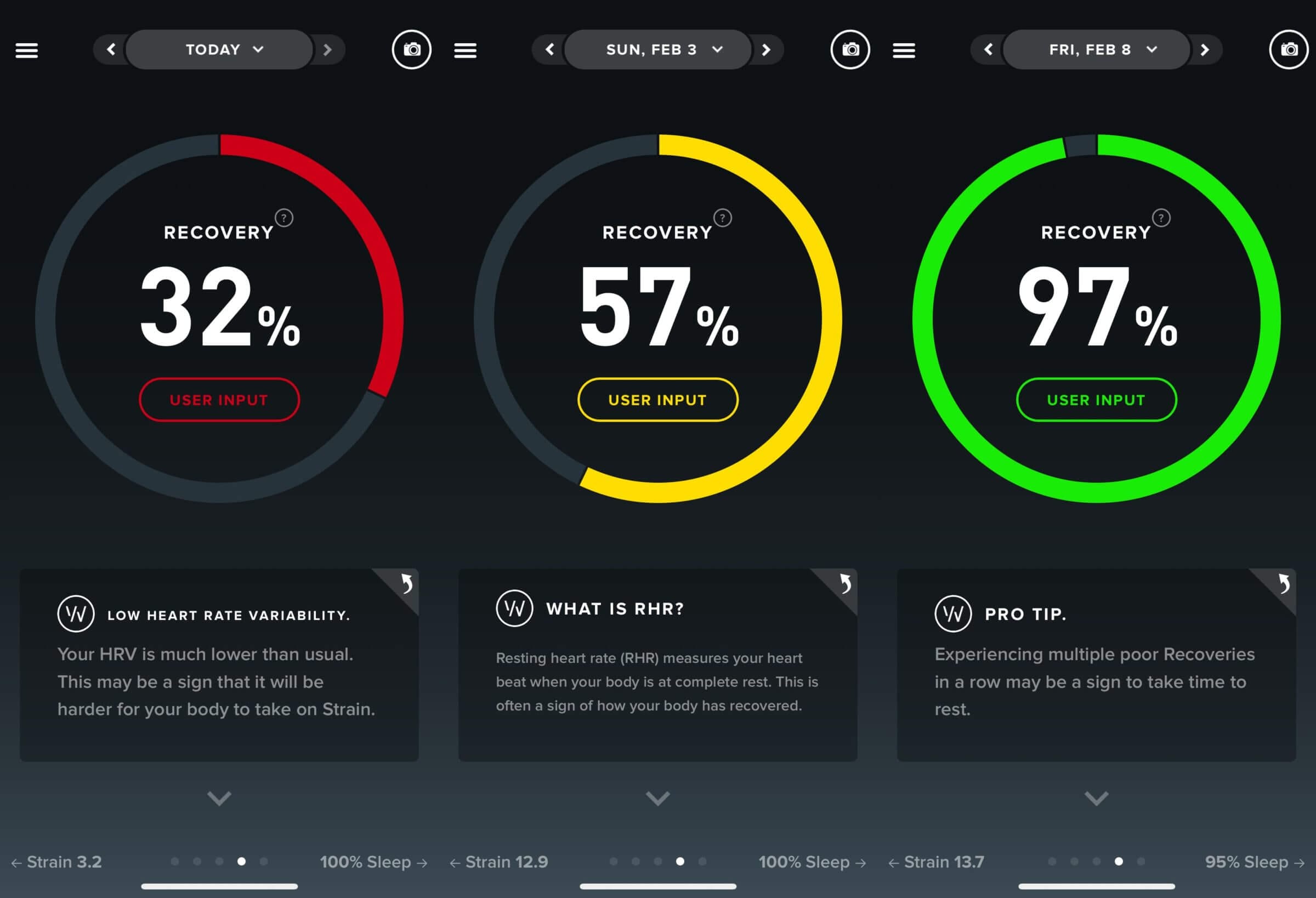
One of the reasons why I’m such a huge fan of WHOOP is because it calculates my daily recovery score, which reflects how my body is responding to stress, exercise, food and other lifestyle factors.
WHOOP achieves this feat by measuring my heart rate variability (HRV) during deep sleep, which is an indirect indication of how well my nervous system is functioning. I wrote in detail about the significance of HRV in my dedicated WHOOP review, so check that out if you’d like to learn more.
But in a nutshell, the competition between the sympathetic and parasympathetic branches of the nervous system influences the timing between heartbeats (measured in milliseconds). A high HRV (compared to your baseline) is an indication that the parasympathetic nervous system (the one that’s responsible for resting and digesting) is activated. That means your body is well recovered and ready to take on strain.
On the flip side, a low HRV means that your body might be struggling with repairing damaged muscle tissue (from a workout or an injury), coping with stress, or fighting an infection.
While changes in HRV are the most important factor used by WHOOP to determine your recovery score, it also takes into account changes in your resting heart rate (compared to your baseline) and the quality of your sleep.
Fitbit offers a similar feature, but the company calls it a “Stress Management” score. Unlike WHOOP, Fitbit calculates this score based on a combination of biometrics captured while sleeping and during the day.
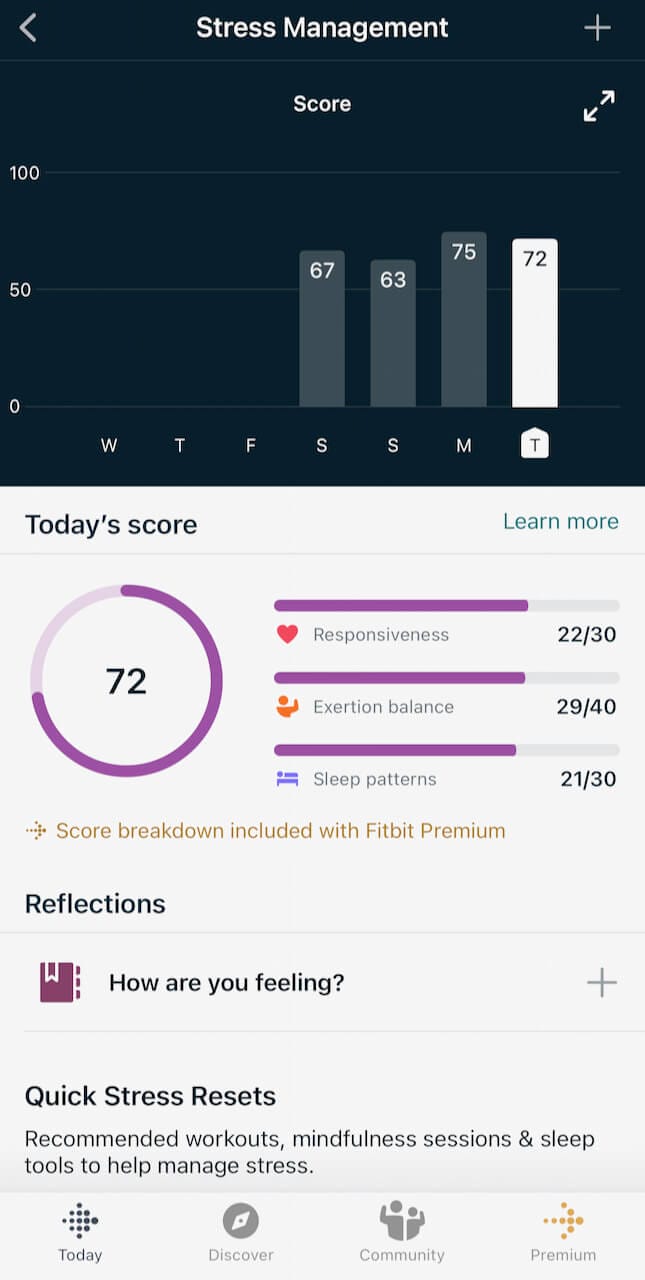
In other words, Fitbit includes the following data categories in its score:
- Responsiveness (30%).
- Exertion (40%).
- Sleep patterns (30%).
The “responsiveness” category includes the following biometric markers:
- Heart rate variability during deep sleep from the night before (same as WHOOP).
- Elevated heart rate while at rest from the day before.
- Sleeping heart rate while at rest from the day before (same as WHOOP).
- Electrodermal activity from the day before based on the EDA Scan app (you have to manually do this scan to make it part of your score).
Based on my experience, I think that #2 and #4 are either irrelevant or impractical. In other words, if Fitbit monitors your resting heart rate during sleep, there’s no need to also keep tabs on your heart rate during periods of no movement throughout the day; doing so doesn’t lead to reliable data.
For example, what if I watch a movie that elevates my heart rate, even though I’m not moving at the time? Or what if I sit on a bike ergometer for a casual bike workout that doesn’t include any wrist movement?
In either case, Fitbit might think that I’m at rest, but it would notice an increase in heart rate and use that information as an indication that I’m stressed.
The “exertion” category includes the following biometrics:
- Daily steps.
- Weekly activity level.
- Fitness levels vs. exercise fatigue.
In my opinion, Fitbit should remove exertion from the equation entirely because it’s irrelevant and weakens the score’s accuracy. Instead, 40% of the stress management score is based on this category, which is crazy in my opinion.
The thing is that your level of activity is not a factor that directly influences your body’s response to it. In other words, if you’re used to a certain level of activity, your body (and nervous system) won’t have any issues dealing with it. But if your body is struggling with overtraining or a new type of workout, you would see that reflected in your heart rate variability, regardless.
So I don’t see the value at all of including activity data in your stress response score.
Last but not least, sleep patterns make up 30% of the stress management score and include the following biometrics:
- Total sleep over the past week.
- Restlessness and other indicators of disrupted sleep from the night before.
- Time spent in REM and deep sleep from the night before.
As you can see, Fitbit takes sleep debt from the past week and sleep quality metrics from the previous night into account. I think that’s smart, but it assumes that Fitbit can accurately track the various stages of sleep, and that’s sometimes not the case (as we’ve seen above).
If you compare my WHOOP recovery score to Fitbit’s stress management score from the past three days, you can see a significant discrepancy.
I realize that a direct comparison is difficult because the devices rely on different data points. However, the principle behind both scores is the same: to reflect how my body is responding to stress.
As of this writing, I feel like my body is run down. That’s probably because I completed an incredibly challenging workout at the end of a two-day fast. Doing so completely depleted the (partially empty) energy stores my body had left after not having eaten for 48 hours.
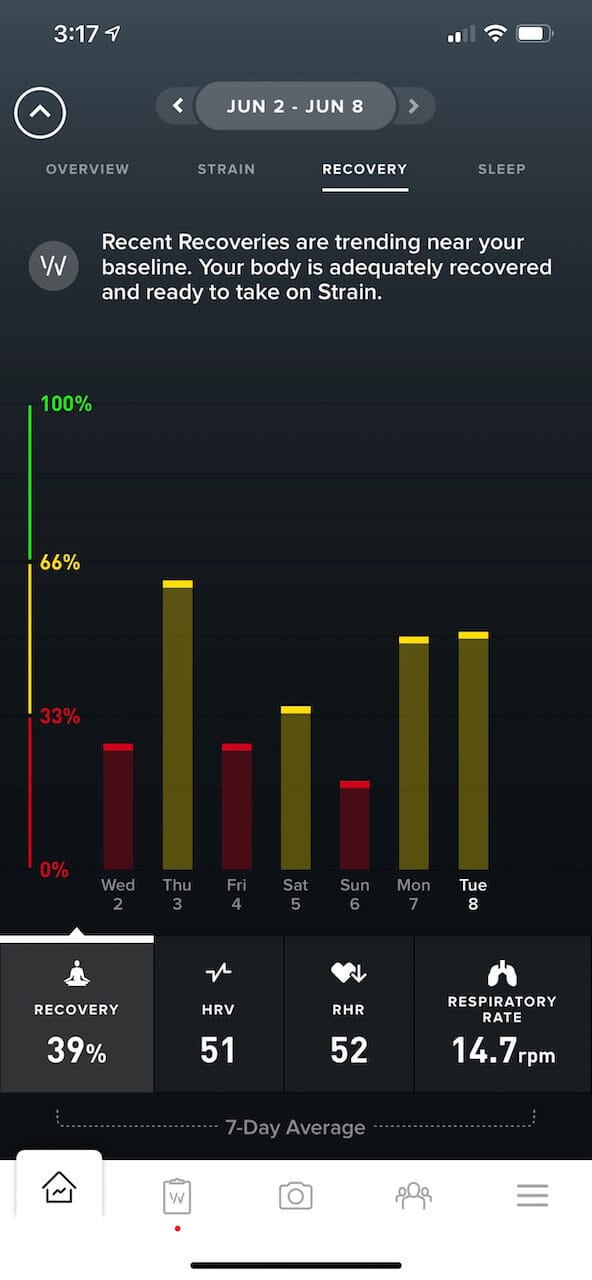
My WHOOP strap has accurately captured how I’ve been feeling, as you can see in the recovery scores from this week.
On the flip side, Fitbit thinks that I’m relatively recovered, scoring 67 out of a possible 100. I don’t feel 67% recovered, and neither does my nervous system (considering the relatively low HRV).
Additionally, Fitbit doesn’t help me interpret that score, giving me zero insight into what action I should take — such as lowering my cardiovascular strain by reducing the intensity of my next workout.


WHOOP clearly communicates how I can balance exertion and recovery by recommending the maximum strain I should accumulate.
Additionally, WHOOP has the ability to correlate my lifestyle choices with changes in my recovery score in the form of the WHOOP Journal. I already mentioned this feature in the section about sleep, but I recommend you check out this article that talks about how I use the WHOOP Journal to optimize my performance.
Mobile App
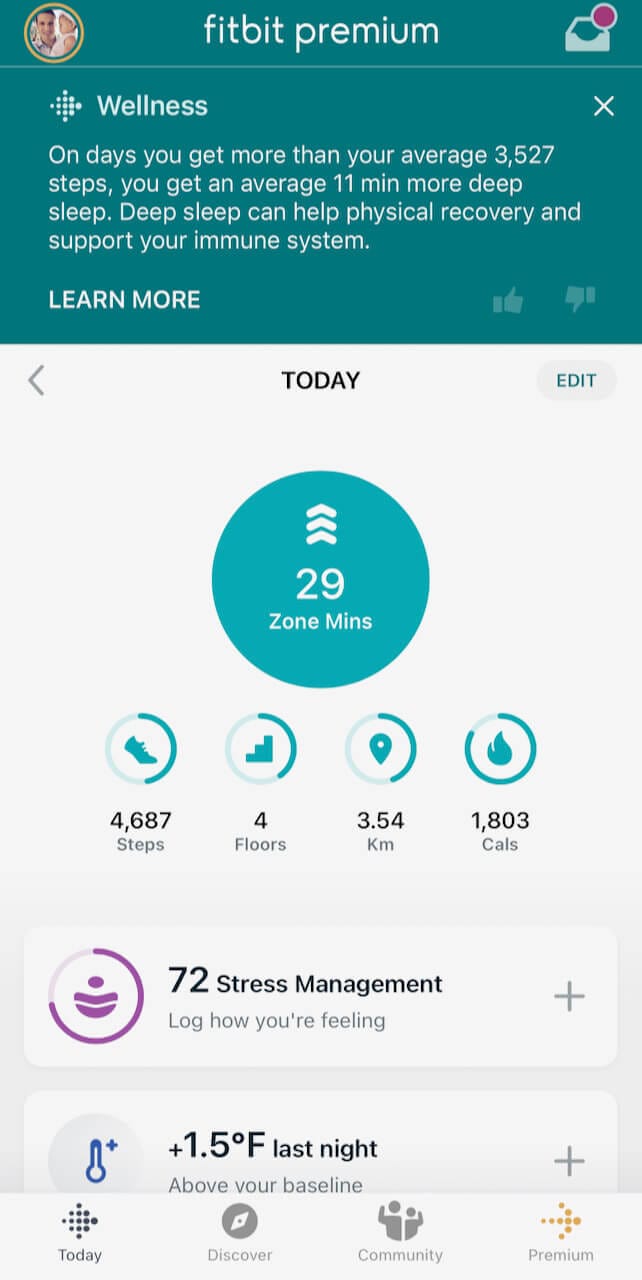
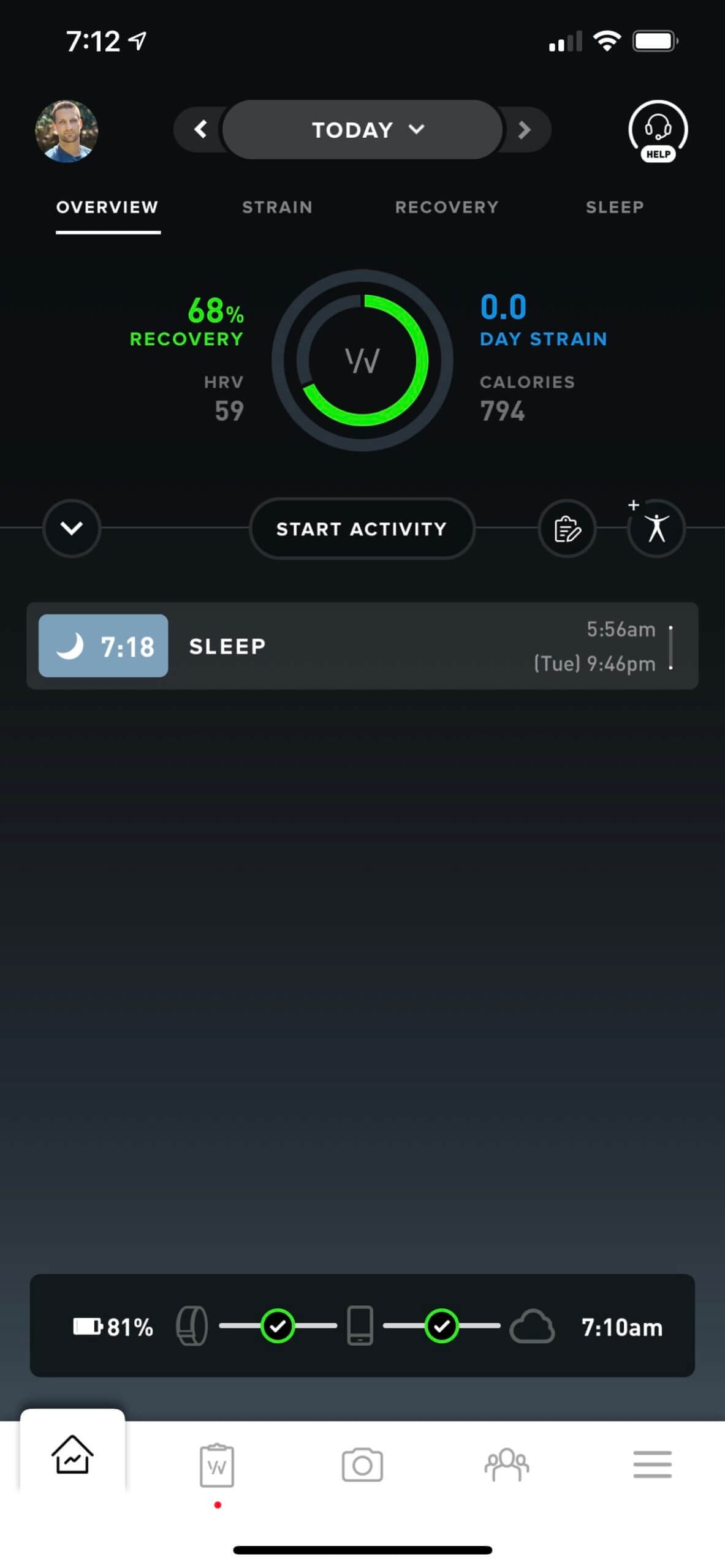
The Fitbit and WHOOP mobile apps are both intuitive and easy to use, offering you an overview of your most important biometrics and stats right on the home screen.
The Fitbit app is broadly split into the following sections or tabs:
- Today
- Discover
- Community
- Premium
When you launch the app, you’re greeted with the Today tab, which shows you a customizable list of core biometrics, such as activity (Zone Mins, steps, floors, kilometers walked and calories), stress management, skin temperature, sleep data and resting heart rate. From there you can drill down into the details.
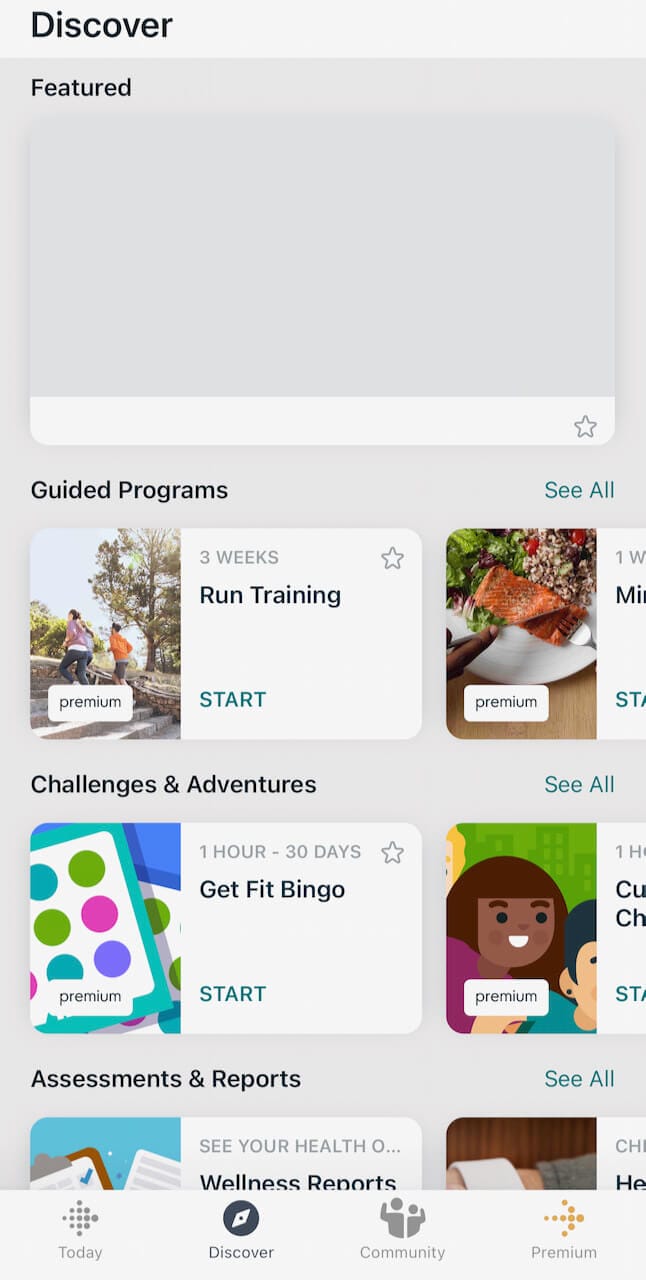
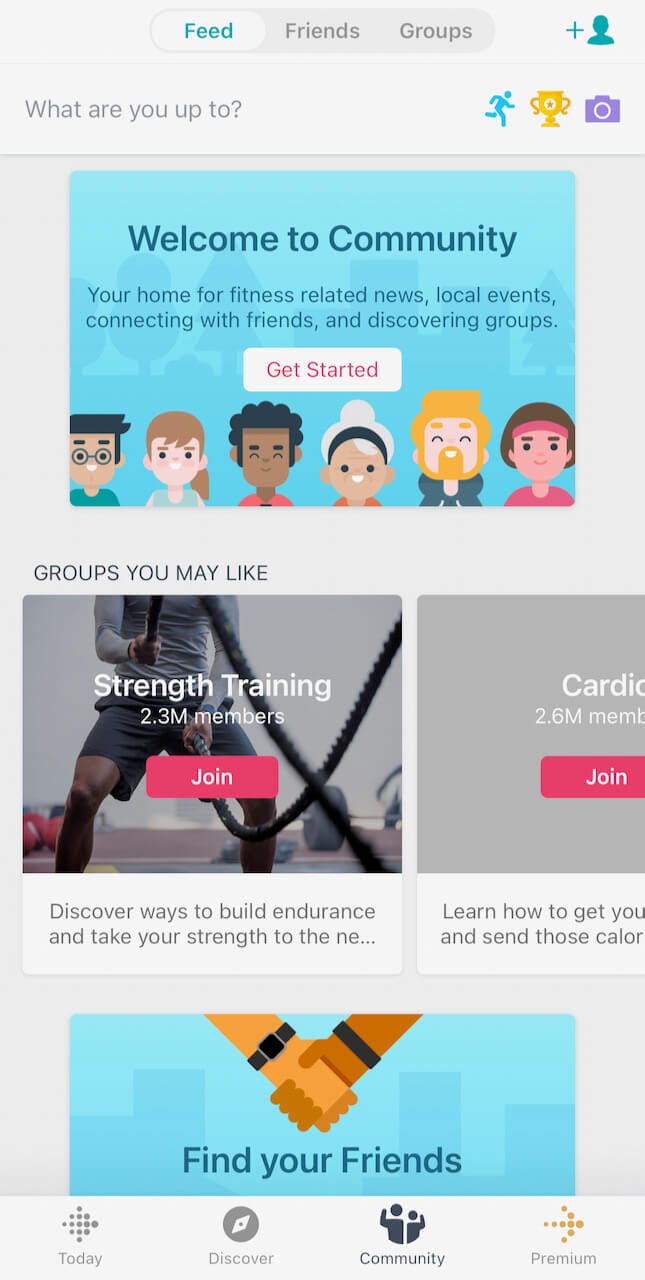
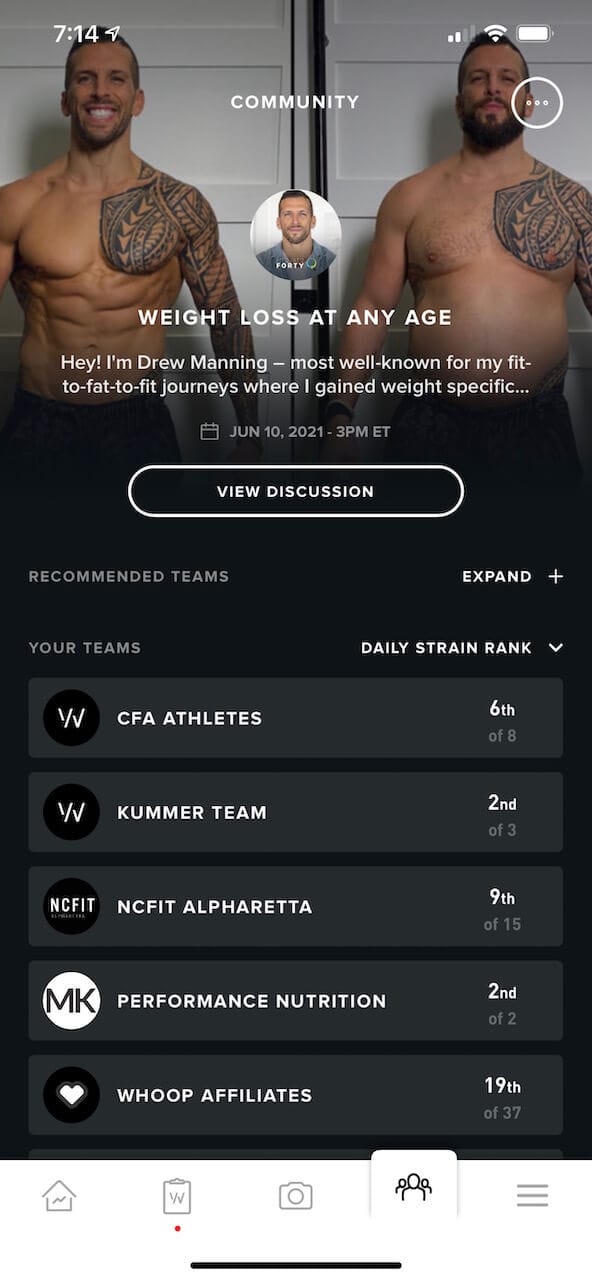
The Discover tab offers guided workout programs, challenges and adventures, assessments and reports, a nutrition section with recipes, mindfulness sessions and more. While some of these programs are free, most of them require a subscription (see pricing below).
WHOOP doesn’t offer any guided exercise programs but it has a strain and sleep coach that can give you recommendations on things like:
- When you should go to bed and wake up (based on your recent sleep patterns and accumulated strain).
- How much strain you should accumulate based on your recovery score.
- Live workout coach that can help you stay below the recommended strain.
WHOOP also offers the ability to create or join teams of other WHOOP members so you can compare high-level metrics, including total sleep, strain and recovery scores. I’m part of several WHOOP Teams, including the one chaired by the owner of my CrossFit box.
Fitbit offers a similar feature that you can access via the app’s Community tab. It allows you to share your activity data with friends or join groups. Of course, you can also create your own group.
The main difference between the community features of WHOOP and Fitbit is that Fitbit’s implementation looks more like a social media platform, where the members of a group can post images and text that others can like and comment on.
I can see how that would be fun for a smaller group consisting of people you know, but I personally don’t have time to engage with yet another social media platform.
Battery Life and Charging
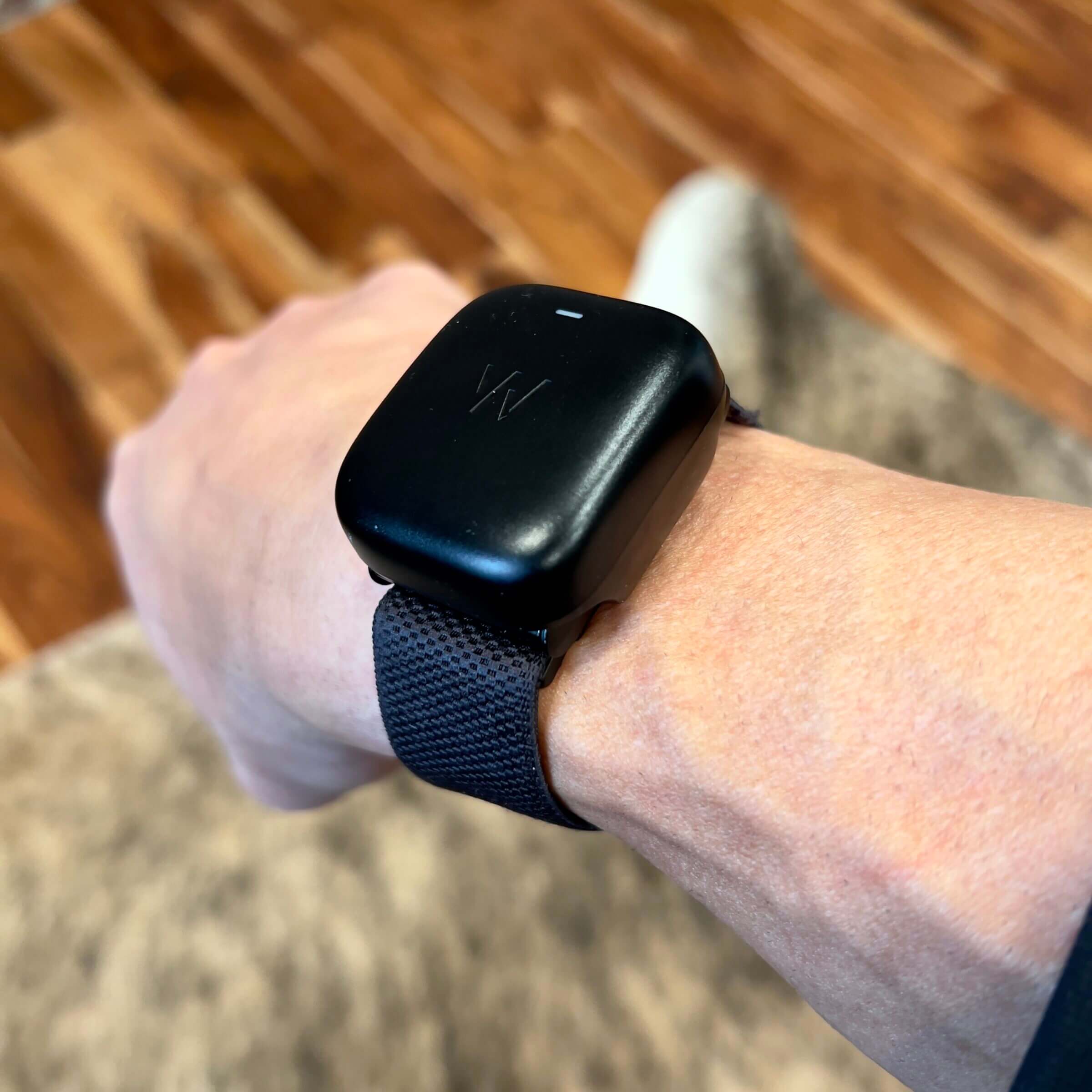
WHOOP and Fitbit offer a comparable battery life of between five and six days.
The difference between these two wearables is that WHOOP’s battery life isn’t impacted by how much time you spend in an elevated heart rate zone. In other words, WHOOP monitors your heart rate 24/7 at a frequency of 100 times per second, regardless of whether you’re sitting in an office chair or running a marathon. Either way, the battery lasts at least five days.
Fitbit Sense’s battery life depends heavily on how often you work out (and for how long). That’s because the device captures heart rate data at a higher frequency during physical activity, which depletes the battery quicker than during times of inactivity.
As a result, you might not get “up to 6+ days” as indicated on Fitbit’s specs page. The good news is that you can extend the Fitbit Sense’s battery life by another day by charging it for 12 minutes. Charging the device from 10% to 80% takes approximately 40 minutes.
Still, I very much prefer WHOOP’s approach to charging because it doesn’t require me to take off the strap. Instead, I can slide on a battery pack that charges WHOOP from zero to 100 in less than 90 minutes. Once my strap has been fully charged, I can take the battery pack off and charge it separately using the included USB-C cable.
Integrations
Both Fitbit and WHOOP offer integration with third-party platforms to facilitate data sharing and consolidation.
Fitbit’s support for third-party platforms is excellent and includes integration with MyFitnessPal, Endomondo, Runkeeper, Apple Health, Strava, Weight Watchers, IFTTT Withings and more.
WHOOP’s support for third-party apps is more limited and includes Strava, Trainingpeaks and (as of early 2022) Apple HealthKit.
Pricing
Fitbit and WHOOP follow different pricing strategies, making a direct comparison a bit challenging.
The MSRP of the Fitbit Sense is $299.95, but if you want to get the most out of this fitness band, you have to sign up for Fitbit’s premium subscription, which costs $9.99 a month or $79.99 a year. As of this writing, if you purchase the Sense, you get a free six-month trial of the Fitbit premium membership.
WHOOP is entirely based on a subscription model. You don’t purchase the hardware; instead, you pay a monthly membership fee that varies depending on the length of your commitment.
If you sign up for WHOOP on a month-to-month basis, you pay $30 per month. If you commit to 12 months, you’ll pay $24 per month. And with an 18-month commitment you can lower the price to $18 per month.
If you’d like to give WHOOP a try, you can use the link above to get an extra month added to your membership for free.
Whoop vs Fitbit: Frequently Asked Questions
In this section, I’m mostly covering questions related to the Fitbit Sense because you can find frequently asked questions about the WHOOP Strap in my dedicated WHOOP review and in this WHOOP FAQ video I published on YouTube.
If you’re invested in the Google/Android ecosystem and you’re looking for a smartwatch and fitness tracker combination, then the Fitbit Sense might be worth it for you. But if you’re an iPhone user, don’t need a smartwatch or just want the most accurate and insightful activity, sleep and recovery tracker available, then I’d get a WHOOP instead.
I also think WHOOP is the best fitness tracker for serious fitness enthusiasts and competitive/semi-professional athletes, as it offers far greater insights into how to actually optimize your performance. The Fitbit platform is better suited for those who need base-level fitness and activity tracking to generally live a healthier lifestyle.
Yes, the Fitbit Sense is compatible with the iPhone, including the iPhone 12 Pro Max, which is what I’ve used for this review.
The Fitbit Sense is a relatively accurate activity tracker but it has the same limitations as all other wrist-worn devices when it comes to tracking heart rate and calories. The Fitbit Sense is also a relatively accurate sleep tracker. But in my tests, it failed to accurately detect the length of my REM sleep on most nights.
Compared to the Apple Watch, I’d consider the Fitbit Sense a good watch but not a great one. In fact, I really missed my Apple Watch while I was wearing the Fitbit Sense and all its features that I’ve become accustomed to, such as the always-on display (which doesn’t reduce the device’s battery life and doesn’t require the download of an extra watch face), actionable notifications, Apple Pay and more.
No, unfortunately, the Fitbit Sense doesn’t support the use of a chest strap. WHOOP also does not offer third-party chest strap support.
The Fitbit Sense measures your heart rate at one-second intervals during exercise tracking and at five-second intervals all other times.
The Fitbit Sense, much like most of Fitbit’s wearable technology, has water resistance to a depth of up to 50 meters. That means you can take your Fitbit Sense into the shower or go for a swim with it without damaging the device.
Based on my experience with the Oura Ring, I’d say that the Fitbit Sense is slightly less accurate when it comes to activity tracking because the Oura Ring is less likely to lose contact with the skin during workouts. As far as sleep stage tracking is concerned, I’ve noticed accuracy issues with both the Oura Ring and the Fitbit, but I’d argue that the Oura Ring might be doing a slightly better job.
The Sense is Fitbit’s premium fitness and health tracker because it packs the most advanced sensors into a small form factor. The Fitbit Versa looks similar but it lacks a couple of features, such as skin temperature monitoring, ECG, EDA and stress tracking.
The Fitbit Charge is an excellent fitness tracker that includes most of the features of the Sense, but it’s not a smart watch. In other words, you can’t answer phone calls or control smart home accessories with it.
On the plus side, the Charge’s battery lasts a full day longer and the device costs significantly less than the Sense.
Yes, the Fitbit Sense has a pulse oximeter to track blood oxygen saturation (SpO2) while you sleep. In the morning, you get a report that shows your SpO2 levels.
To measure blood oxygen saturation, Fitbit (and WHOOP) uses its red and infrared LEDs to shine light onto your skin and blood vessels. Based on the reflection of the light, Fitbit can differentiate between richly oxygenated and poorly oxygenated blood because the latter reflects less infrared than red light.
Unlike the Apple Watch Series 4 and later, the Fitbit Sense doesn’t have a fall detection feature as of this writing.
Yes, you have to wear Fitbit on your wrist because the company doesn’t offer any alternative wearing options. In contract, WHOOP offers a bicep strap and WHOOP Body, a line of functional clothing that enables you to wear the sensor on your hips or arms.
Should You Get the WHOOP Strap or Fitbit Sense?
If you’ve read this entire article, you should have a good understanding of which fitness tracker is right for you. But to help you with the decision-making process, here’s my take on who should get a WHOOP vs. a Fitbit.
Who Should Consider the Fitbit Sense
The Fitbit Sense is one of the more capable fitness and sleep trackers I’ve tested so far. What’s more, the Fitbit Sense has a lot of other features that go way beyond fitness tracking.
So if you’re in the market for a smartwatch that can double as a fitness tracker and you’re already invested in the Google/Android ecosystem (as opposed to the Apple ecosystem), then the Fitbit Sense could be an attractive option for you.
That’s especially true if you enjoy such features as Google Pay (to pay for groceries at stores that support it) or issuing voice commands to Amazon’s Alexa or Google Assistant.
Who Should Consider the WHOOP Strap
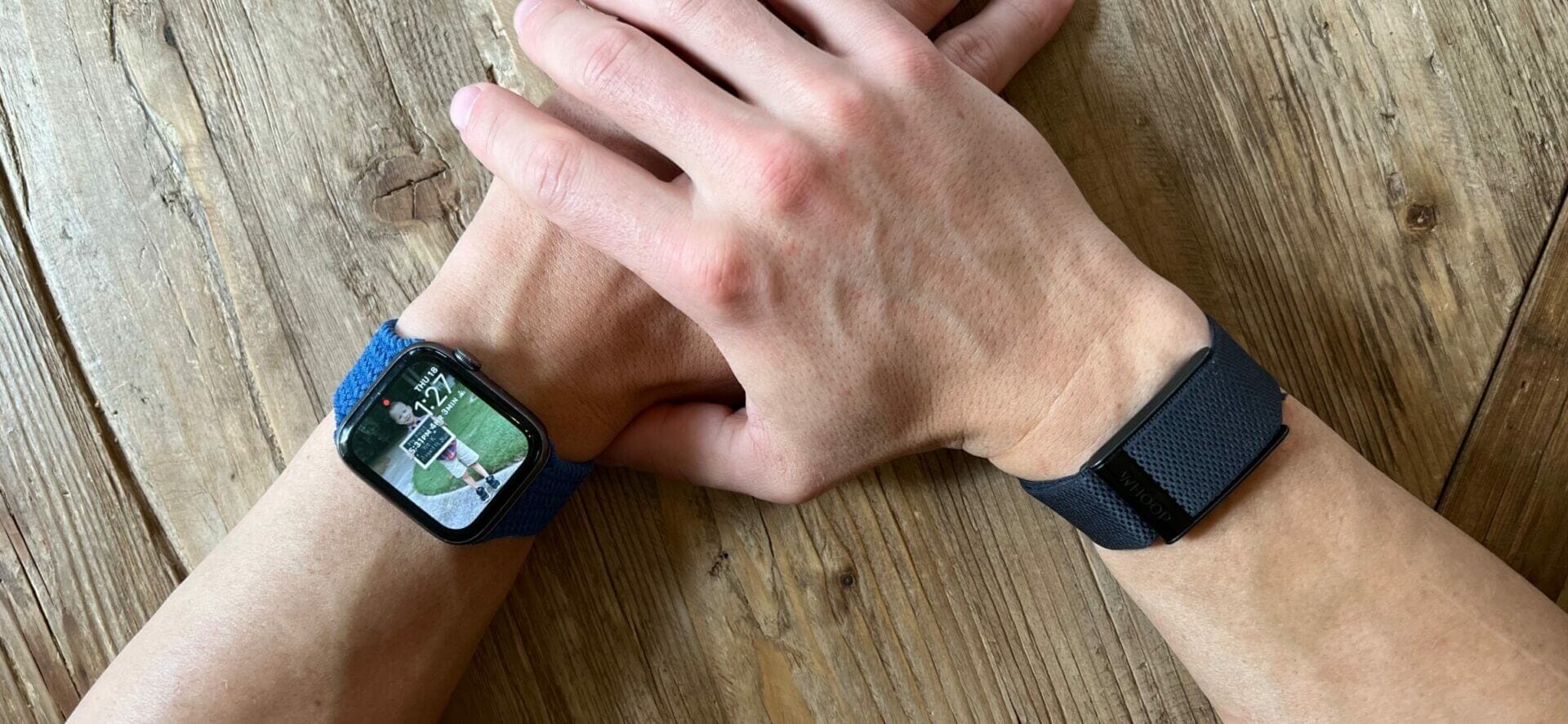
If you already own a smartwatch (or don’t want one) and you simply want the best wearable on the market — one that combines activity, sleep and recovery tracking to help you unlock the secrets your body is trying to tell you — then you should get a WHOOP Strap.
It’s hands-down the best sleep and recovery tracker I’ve ever tested and it’s relatively accurate when it comes to activity tracking. The only downside of WHOOP is that it’s not a smartwatch and that’s the reason why I’ve been wearing both the WHOOP Strap and an Apple Watch for the past few years.
WHOOP vs. Fitbit: Final Thoughts
I had relatively low expectations for the Fitbit Sense going into this review based on my past experience with the features and functionality of Fitbit’s wearable technology.
But I have to admit that I was positively surprised by the breadth of features that Fitbit managed to pack into the Sense fitness band. I was also surprised by how relatively accurate the Fitbit Sense tracks most stages of sleep (with the exception of REM sleep).
Nevertheless, I decided to return my Fitbit Sense because I concluded that WHOOP does a much better job at activity, sleep and recovery tracking. Plus, my Apple Watch does a much better job at everything else (timekeeping, notifications, integration into the Apple ecosystem, etc.).
In other words, the Fitbit Sense doesn’t outperform the WHOOP or my Apple Watch in any category that I care about.
That’s why I’m returning my Fitbit to make room on my wrist for something new (maybe a Polar Vantage M or a Garmin Fenix 6). Let me know in the comments below what fitness tracker you want me to review next!

Michael is a healthy living enthusiast and CrossFit athlete whose goal is to help people achieve optimal health by bridging the gap between ancestral living and the demands of modern society.
Medical Disclaimer
The information shared on this blog is for educational purposes only, is not a substitute for the advice of medical doctors or registered dieticians (which we are not) and should not be used to prevent, diagnose, or treat any condition. Consult with a physician before starting a fitness regimen, adding supplements to your diet, or making other changes that may affect your medications, treatment plan or overall health. MichaelKummer.com and its owner MK Media Group, LLC are not liable for how you use and implement the information shared here, which is based on the opinions of the authors formed after engaging in personal use and research. We recommend products, services, or programs and are sometimes compensated for doing so as affiliates. Please read our Terms and Conditions for further information, including our privacy policy.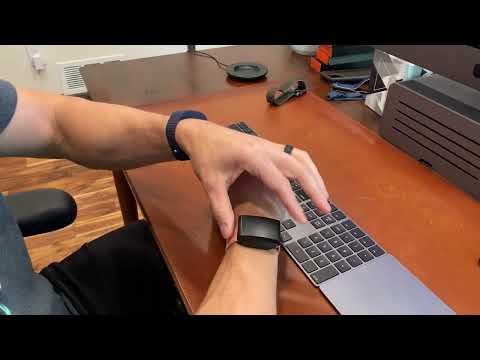

Thanks for detailed review. I’m curious, do you wear Whoop and Apple watch at the same time on different wrists or change them depending on what you’re doing?
Hi Viktor!
I wear my Apple Watch on my left and WHOOP on my right wrist!
Cheers,
Michael
I am currently wearing the whoop and Fitbit charge 5 on my wrist for the last two months. Most readings are similar. However I do find a discrepancy in hrv and rhr reading. I’m assuming the whoop reading is more reliable? Is that your assumption as well?
Yeah, I trust WHOOP more than I do Fitbit.
Great article!! Do you know if the raw score for HRV on whoop is computed the same way as with Fitbit premium? When I get an HRV in the 40’s I usually get a recovery score in the 90’s. My wife’s Fitbit HRV scores range between 50-91, which makes me think they’re reporting different numbers using different algorithms.
Hi Brent,
I don’t know for sure but if I had to guess, I’d say they use different algorithms or algorithm implementations.
PS: Apologies for the late reply. Your comment got accidentally deleted by my anti-spam plugin and I just found out about it.
I am loving my Whoop but miss having something on my wrist that gives me some data (even if it’s just the time of day). I am now wondering if a Garmin watch will give me the same or similar recovery insights as the Whoop.
Please review and compare a Garmin watch (such as the Forerunner 945) and Garmin’s app ecosystem to Whoop. Garmin seems to have a VO2 MAX indicator, body battery, performance condition, training status, training load, recovery time, and sleep tracking. The bonus of the Garmin is that this data is on your wrist and I am hoping that further insights can also be displayed inside their app like Whoop. I think it is definitely worth comparing the two, especially with your in depth knowledge on how the whoop works. Thanks for all of your detailed reports, it is greatly appreciated!
Ryan
Thanks for the suggestion! I’m taking a look at the new Biostrap Evo next but had planned to get a Polar and Garmin to test as well.